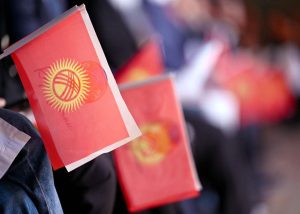On November 29, Kyrgyzstan’s parliament passed the first reading of a bill that would redesign specific elements of the country’s flag.
Article 3 of the law “About the state symbols of the Kyrgyz Republic” lays out the dimensions of the flag and its design components. The flag features a “round solar disk with forty evenly diverging rays of golden color, with an image of a red Kyrgyz yurt tunduk placed inside the solar disk.” The bill, proposed in September, calls for changing the design of the rays. Ulan Primov, one of the bill’s authors, said it was easy to confuse the rays for a sunflower.
The word “sunflower” in Kyrgyz can be used derogatorily to denote fickleness or a lack of independence. In a speech against the bill, deputy Mirlan Samyikozho stooped to a bit of name calling when he said, “Whoever says that the sun rays are like a sunflower is a sunflower themselves.”
There were three proposed changes to the flag: the first pitched by parliament back in September, edits by the president’s office in October, and a final version that was voted on this week. All of the proposed flag designs include a yellow tunduk inside a sun with forty rays against a red background.
Parliament’s first effort straightens out the rays, which in the original are curved (and, if one squints, could be seen as petals on a sunflower). The president’s office tweaked that by plucking each ray from the strip of yellow around the tunduk. The president’s version has alternating lengths of rays, which, though it may more accurately represent the sun, could insinuate that some of the forty tribes that the rays represent are stronger or more powerful than others. Perhaps anticipating such criticism, Jogorku Kenesh’s final markup has all of the rays measuring at equal length.
Deputies also increased the number of slats on the tunduk from three to four. Nurlan Shakiev, who has been the speaker of parliament since October 2022, explained during deliberations, “They said that only the rich, prosperous Kyrgyz had four tunduk rods in the yurts, while the poor had three.”
In the November 29 vote, 66 deputies voted in favor of a new design (well, 65, given that deputy Mirlan Samyikozho claimed someone pressed the “for” button while he was away). Eight deputies voted no, 10 abstained, and six did not vote altogether.
Erlan Kokulov, a member of the Yntymak party, criticized the process for lacking democratic integrity. “We rushed again. We could not ask questions. The flag is not only ours, but it belongs to every citizen,” Kokulov said. “This issue should have been resolved by a referendum.”
Elections are expensive, though, and it is unlikely the design will be put to a formal vote.
Azattyk, the Kyrgyz-language branch of Radio Free Europe/Radio Liberty, conducted an informal survey about the proposed changes to the flag on YouTube. As of November 30, 38,000 people had voted, with 80 percent supporting the original design. Some 13 percent liked the president’s pitch. Only 5 percent approved parliament’s final markup.
This is not the first time Kyrgyzstan’s lawmakers have tried to change the flag, which was adopted in 1992 just days after the country joined the United Nations as an independent state. In 2011, parliament set up a committee of 15 deputies to discuss the flag’s design. Abdyrakhman Mamataliev, the deputy who chaired the committee, recounted that a light blue flag would evoke less violent images than red, a color that symbolizes blood. Mamataliev also called for bringing back the Soviet-era tricolor flag, but swapping out the hammer and sickle with a tunduk.
Compared to those changes, tweaks to the shape of the sun rays seem minor. Countries change the details and ornamentation of their flags all the time. In 2021, France shifted the blue in their tricolor to a slightly darker navy. In 2022, Honduras changed the stripes and stars on its flag from dark blue back to turquoise. Primov, one of the bill’s authors, cited the frequency of changes to flags in the United States and Spain to justify the Kyrgyz design change.
In an interview with Kabar on October 25, President Sadyr Japarov said that while he is “far from superstitious,” it is nevertheless important to “hope that from now on, we will be a developed an independent country, like the rays of the sun on our flag entering through the tunduk.”
Average people are not so sure about the transformative power of the flag’s design change, though. When local media outlet Kaktus conducted street interviews in Bishkek back in October, people not only said they prefer the original design, but that they think this whole bill is a distraction from actual societal problems. Respondents cited rising taxes, inflation, domestic violence, and crumbling roads.
“I don’t get it. If we change the flag, then everyone will be fed, they won’t shut off electricity in the winter, houses will be warm, and food will be cheaper?” Avazbek Amanbekov, a world class champion kickboxer, posted on his Instagram stories. “Are we really going to compete under a different flag now?”
The bill has passed only its first reading and still needs to be voted on two more times before it goes to Japarov’s desk to be signed into law. It could be that this bill fizzles out of fashion, similar to a failed attempt to penalize those who use images of the flag that do not exactly match the specifications laid out by law.
































